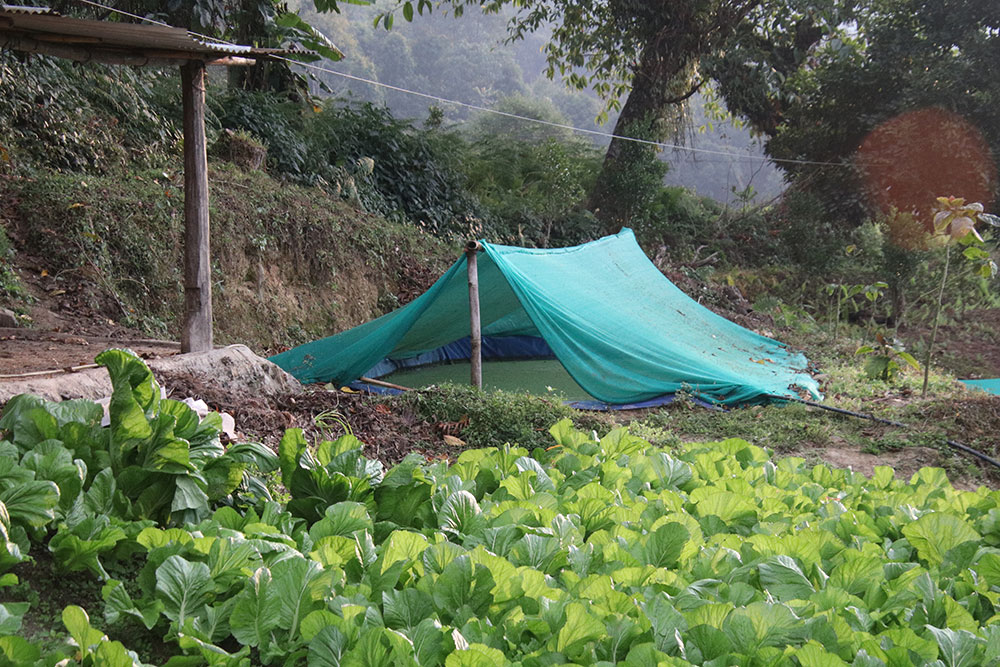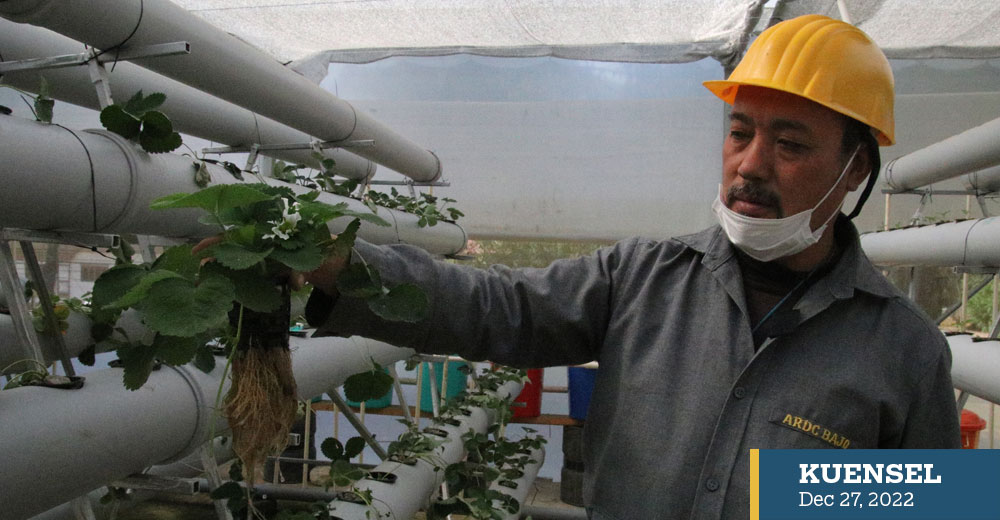Chhimi Dema
Five years ago, farmers from Salari village in Barshong, Tsirang had to carry water in buckets to irrigate their fields.
A resident of Salari, Tshering Zangmo, woke up most days at midnight to fetch water for irrigation and drinking.
Today, they enjoy proper sleep. The scarcity is no more because of climate-smart technology, water harvesting pond technology.
The low-cost plastic-lined water harvesting pond technology can store rainwater or runoff water used during the dry or lean season for agriculture and household purposes.
In Barshong, Tsirang, the water harvest technology was introduced in 2014 with support from the International Centre for Integrated Mountain Development.
The technology was later modified and improved to suit the country’s topography.
Tshering Zangmo installed two water harvesting ponds five years ago.
She said that her vegetable production increased threefold. “This technology has greatly helped and increased my income from vegetable farming.”
Tshering Zangmo pumps water from the pond and connects it to her field. The pond is kept open to collect rainwater; when not in use, she connects it to the drinking water line.
“The technology is convenient and helps strengthen our livelihood. I am grateful for it,” she said.
Tshering Zangmo invested Nu 40,000 to construct two water-harvesting ponds.

Water harvesting pond at Mendrelgang
The water harvest pond depending on its size can store water from 16.97 to 41.60 cubic litres.
A pond is dug first based on specifications the agriculture ministry developed. Based on the size of the pond, a tarpaulin sheet is laid inside to stop water from entering the ground.
Farmers can store rainwater, water from perennial sources or connect with drinking pipelines. Water from it can be used by pumping or constructing pipes in the pond.
Currently, there are 230 farmers in Tsirang and 350 farmers in Dagana using water-harvesting technology.
Tsirang’s agriculture officer, Dorji Gyeltshen, said that water-harvesting technology is the most important climate-smart technology in agriculture. “If we cannot adapt to climate change then we fall victim to it.”
The water-harvesting technology allows farmers to collect water which can be used during water scarcity or prolonged drought, Dorji Gyeltshen said.
“The water cycle is disrupted because of climate change and it causes erratic rainfall. On rainy days we have to harvest the water to use it during its shortage. This is how we build resilience to climate change,” he added.
Phurba Moktan, a farmer in Mendrelgang, constructed the water-harvesting technology five years ago.
He has connected the pond to a bio-digester which provides both water and nutrients in the field. In winter, he pumps water from the spring near his house and connects it to the pond, and in summer, he collects rainwater.
Phurba Moktan said that he could start commercial farming after the construction of the water-harvesting pond. “Before we could only produce vegetables to meet our household demand, beyond that it was difficult with the shortage of water.”
Today in a month he earns from Nu 10,000 to Nu 15,000 selling vegetables such as cabbage and cauliflower.
Food and Agriculture Organisation (FAO)’s report on Coping with Water Scarcity in Agriculture states that the excessive use and degradation of water resources are threatening the sustainability of livelihoods dependent on water and agriculture.
Water scarcity is expected to intensify as a result of climate change with frequent and severe droughts affecting agriculture production, according to the report.
FAO recommended improving agricultural water productivity sustainably; improving and climate-proofing irrigation services and infrastructure; and planning, designing and managing multiple water resources, among others to address water scarcity in the agriculture sector.
Water storage (such as reservoirs and ponds) and water-supply infrastructure can be designed and managed in ways that more effectively serve the needs of water users for irrigation, livestock, gardens, habitats for fish and other aquatic resources, transport, hydroelectric power generation and the environment.
“Multiple benefits can be derived from the synergetic use of water resources, resulting in greater water-use efficiency and more services for all,” the report stated.
In the country, agriculture research and development centres are introducing and testing various climate-smart technologies to build resilience against climate change.
Agriculture Research and Development Centre (ARDC) at Bajo is testing technologies such as biochar (charcoal-like substance that is made by burning organic material), bokashi (fermented organic matter), smart greenhouses, hydroponics, various types of irrigation, and other technologies before introducing them to the farmers.
ARDC Bajo’s programme director also the focal for the water-harvesting technology, Pema Chofil, said that the water-harvesting technology is successful because it is low-cost and implemented on a household level.
“The vegetable production success that Tsirang and Dagana farmers experience today is because of the water-harvesting technology,” he said.
Pema Chofil said that with changing climate the world is facing water management issues. “Proper water management solves much of the problem in the agriculture sector.”
He said that farmers in other dzongkhags are interested in investing in water-harvesting technology.
Currently, the Ministry of Agriculture and Forests with support from FAO, Green Climate Fund, and International Fund for Agriculture Development is working on various projects in the country to promote climate-smart approaches in the agriculture sector.
The story is funded by Bhutan Media Foundation’s climate change reporting grant.


